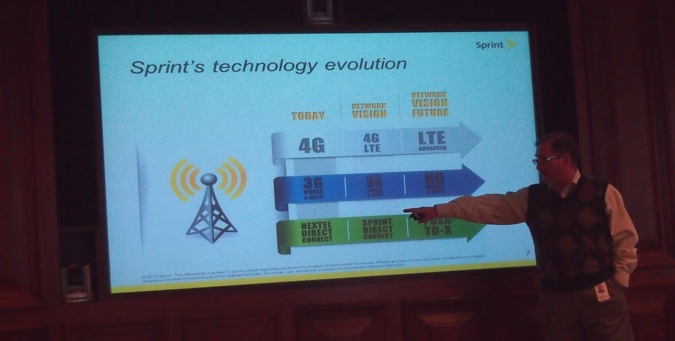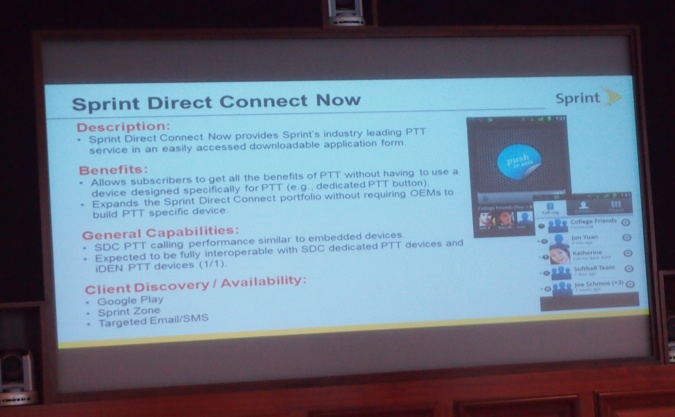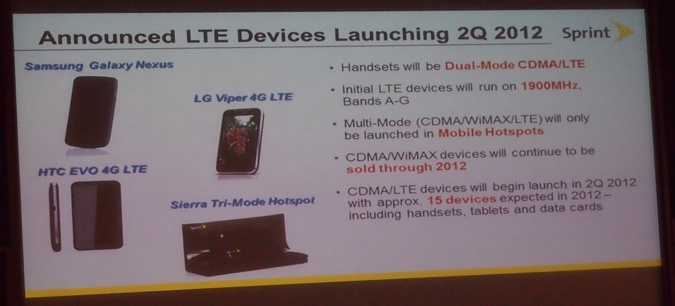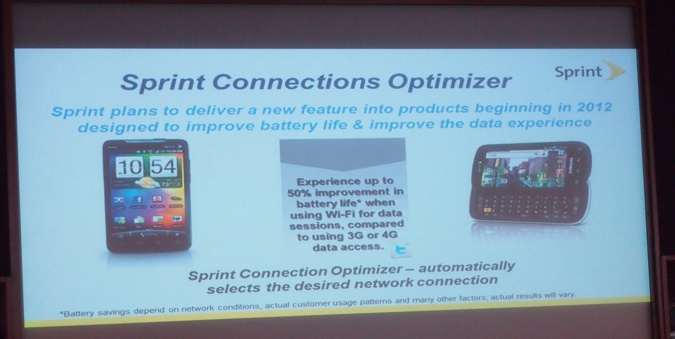Inside Sprint's 4G Comeback Plan: Will it Work?
It wasn't that long ago that Sprint was the 4G leader in the U.S. The carrier was first to roll out a high-speed wireless network way back in 2008 in partnership with Clearwire. As it turns out, the underlying Mobile WiMax technology lost out to LTE as it gained momentum worldwide, and Sprint was left scrambling to devise a new strategy. Now that strategy seems to be coming together, as we learned during two days of briefings with a small group of reporters at Sprint's sprawling Overland Park, KS headquarters.
Acknowledging that playing catch-up won't be easy, executives provided a deep dive on the carrier's multi-pronged strategy to take AT&T and Verizon Wireless head on. Sprint also shared how it plans to differentiate as it narrows the coverage gap and let us get a taste of what those LTE speeds will be like on new devices like the EVO 4G LTE and LG Viper.
Network Vision: Multiple Bands, Increasing Coverage
Sprint is utilizing its 1900 MHz spectrum for rolling out 4G LTE. By the middle of this year, you'll see service roll out to Atlanta, Baltimore, Dallas, Houston, Kansas City and San Antonio. By the end of the year, Sprint plans to cover more than 120 million people, which will grow to 250 million by the end of 2013.
As Steve Elfman, president of Sprint's network operations and wholesale, put it "it's time to invest." But the carrier also expects to save money with its multimode network approach, which enables multiple technologies and spectrum to be deployed on a common platform. Other cost savings will come in the form of roaming reductions as Sprint builds out more of its own footprint.
By 2014, Sprint plans to augment its 4G LTE network by deploying in the 800 MHz band, which will give the carrier better reach (the lower the frequency, the further the signal travels). In order to do this, Sprint will move its iDEN (push to talk) customers off of this frequency so that it can use it for LTE. AT&T and Verizon both operate their 4G LTE networks on 700 MHz.
Elfman also stressed that Sprint learned a lot about 4G through its relationship with Clearwire, especially the hand-offs between WiMax and CDMA (3G). In fact, Sprint will utilize Clearwire's 2.5-GHz network for extra capacity once the provider transitions from WiMAX to LTE. Sprint executives didn't invoke the name of LightSquared much during our briefing, which makes sense given the troubled company's falling out with the government over its network's reported interference with GPS service.
Sign up to receive The Snapshot, a free special dispatch from Laptop Mag, in your inbox.
Will it Be Fast Enough?
One of the challenges for Sprint is that it's launching its LTE network using 5x5 MHz channels, as opposed to 10x10 for Verizon and the majority of AT&T's LTE coverage. In Chicago, where AT&T operates a 5x5 network, we saw significantly slower throughput in our testing.
Bob Azzi, senior vice president of networks, stressed that Sprint will have an offering that's competitive with AT&T and Verizon. "As we fill up 5x5 blocks we have options to fill in capacity and have the paths to grow," he said.
Azzi also reminded the group that the carrier has half the customers as Verizon, so that even with a fully loaded network performance will be comparable. That's where the spectrum bands other than 1900 MHz come in.
Where Sprint says it plans to excel is in the hand-offs between its 3G and 4G networks, which has been a pain point for Verizon customers. The key is Sprint's implementation of implementation of eHRPD (Enhanced High Rate Packet Date), which enables that transition. According to Iyad Tarazi, Sprint's vice president of network development and engineering, hand-offs should be faster and smoother than the competition, saying it should take just a "handful of seconds."
Unlimited 4G...At Least For Now
Sprint remains the only carrier that offers unlimited 4G data on its smartphones, and the carrier has confirmed that 4G LTE will be unlimited as well. According to Paget Alves, Sprint's chief sales officer, unlimited 4G is going the message that drives the bulk of Sprint's advertising for the foreseeable future--even if customers still need to be educated as to what LTE can do for them.
"There's not much of an understanding of WiMax vs. LTE," Alves said. "And there's a limited understanding of the real differences even in business." What's more important for Sprint is to drive home the point that its customers don't have to watch that data meter, and Alves told us we should expect to see more ads that emphasize this major difference between AT&T and Verizon.
At the same time, Alves acknowledged that you won't see Sprint ads showing customers streaming Netflix all day, because it has to be protective of its network. He also couldn't promise that 4G would be unlimited indefinitely as smartphone users become demonstrate an ever-more voracious data appetite. "I can't say that it's going to be there for 2 to 4 years," Alves said.
Nevertheless, Sprint's plan is to play up its unlimited advantage as long as it can.
Push to Talk, Evolved
Although many smartphone users treat push-to-talk like an afterthought, Sprint believes it can revitalize this feature on smartphones. PTT is moving from the dedicated iDEN network to CDMA via a downloadable app on Android smartphones, powered by QChat.
In the short term, Sprint Direct Connect will benefit from a shorter connection time than what it had on iDEN, which will please business customers who have come to rely on the feature. Alves pointed to theme parks like Disney World, which have become "completely dependent on the iDEN network." The challenge is getting everyone else excited about push-to-talk.
To do that, Sprint is hoping to make its software more versatile with "Push to X" capabilities. So instead of just voice, you'll be able to push-to-video or share photos with a single contact or group of contacts with the touch of a button. Some liken this technology to RIM's BBM, but that works across carriers.
Sprint will need to demonstrate that Push to X will be exciting enough to get your friends and family to sign up, too, which could be a tall order. Nevertheless, Fared Adib, vice president of product development for devices at Sprint, is optimistic that the new Direct Connect will resonate with customers. "Network Vision will make push to talk more ubiquitous," Adib said. "Customers will be able to download this client."
Here Come the Devices
It's one thing to play around with new Sprint 4G phones like the LG Viper and EVO 4G LTE over 3G, but it's quite another to experience the speeds Sprint promises to deliver when the carrier begins lighting up its LTE network this summer. We got a taste of that future on Sprint's campus, where the carrier has installed an LTE base station to simulate real-world 4G performance.
As one rep joked, the speeds should be fast because there weren't many devices in the room. But at least the website load times were on a par with or better than what AT&T and Verizon offer. When we took the LG Viper for a spin, mobile sites like ESPN and CNN loaded within 4 to 5 seconds, and the full Laptopmag.com site took 9 seconds to load.
Overall, Sprint will deliver 15 LTE devices this year, including phones, tablets, and data cards like the Sierra Wireless Tri-Mode hotspot, which will ride on both LTE and WiMax. All phones will skip WiMax in favor of LTE going forward. Qualcom's new Snapdragon S4 chip is critical, said Adib, because it will support the bands Sprint will use for its 4G rollout. Over 40 4G LTE devices are planned for 2013.
Sprint wouldn't give any hard numbers on battery life, but Adib did say that its 4G LTE phones are thus far delivering better endurance in testing than its WiMAX phones. The carrier is also including a new tool called Sprint Connections Optimizer. It automatically selects the desired network connection (Wi-Fi or 4G) and promises up to a 50 percent improvement in battery life when using Wi-Fi. Adib said Connections Optimizer "is more intelligent than Apple's solution" and walk users through the setup process.
Sprint's highest-end devices, such as the EVO 4G LTE, will have another differentiating feature in HD Voice, which will deliver high-fidelity voice calls over Sprint's existing 3G network. The codec Sprint selected will actually use less capacity on its network than the current codec.
Outlook
There's no question that Sprint faces an uphill battle in challenging Verizon's mammoth LTE footprint and AT&T significant growth. But the carrier sounds confident that it can be competitive in the next stage of the 4G wars. That will include LTE Advanced, which will ramp up the average download speeds from 5 to 12 Mbps to 12 to 15 Mbps starting in early 2013.
In the meantime, Sprint will need to demonstrate that it can roll out its initial markets on time and stay true to its unlimited data promise.
The biggest challenge for Sprint? Getting customers excited about 4G LTE devices long before coverage comes to their neck of the woods. Alves acknowledged the obstacle but didn't seem too concerned about the lag between device availability and network support, saying "We can set expectations that there's going to be coverage within 18 months."








